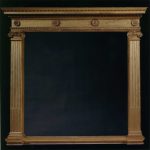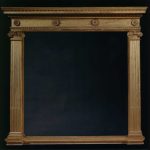9231 A NEOCLASSICAL GILTWOOD MIRROR BY REPUTE MADE FOR THE GARDEN PAVILION, BUCKINGHAM PALACE, POSSIBLY BY GEORGE MORANT AND SONS English. Circa 1840. Measurements: Height: 56 1/4″ (143 cm) Width: 60 1/4″ (153 cm) Depth: 5 1/4″ (13.5 cm)

Research
Of giltwood. The cornice with shaped undermold above a bead and real molded band and dentil molding above a plain frieze set with foliate paterae, above a band of repeating foliate molding, raised on stop-fluted Ionic flanking the rectangular mirror plate, the whole set above a channeled frieze and molded base.
Provenance:
William Clegg and Harvey Ferry, Oxon, UK
According to the vendor of this piece, who had also supplied another piece with certain Buckingham Palace provenance, the present mirror is likely the work of the celebrated firm of royal decorators George Morant and Sons and formerly stood in the Garden Pavilion at Buckingham Palace, built in 1843-5.
The harmonious proportions of the mirror, with the finely executed detailing of the columns and the molded decoration, mark the piece as an object of unusual refinement. The recent provenance of the mirror places it in the same collection as that of a giltwood centre table, attributed to the firm of Morant and Sons, which originally stood in the spectacular domed Octagon of the Garden Pavilion at Buckingham Palace (Carlton Hobbs: 2705). The standard of craftsmanship in the mirror, it’s restrained neoclassical decorative vocabulary, and the type of gilding used, all closely relate it to that piece and strongly suggest that the mirror originally formed part of the same scheme of decorations as that table.
The Garden Pavilion of Buckingham Palace, sadly destroyed in 1928, was designed as a showcase for the attainments of the leading designers and decorators of the day, and was in particular intended to promote the great Victorian revival of fresco painting. The project was undertaken with the support of Queen Victoria and Prince Albert, the latter of whom was closely involved in the enterprise with the assistance of his advisor in artistic matters Ludwig Grüner. It is through Grüner’s publication in 1846 of his The Decorations of the Garden Pavilion in the grounds of Buckingham Palace that the appearance, plan and decoration of the Garden Pavilion is known to us. The Morant and Sons center table to which the present mirror is related appears in that publication among other pieces from the royal collection used to furnish the pavilion.1
The interior of the Pavilion was conceived as a series of daringly original rooms, each in a different style, including a room decorated with frescoes drawn from the novels of Walter Scott and a Pompeian Room decorated by the painter and lithographer Agostino Aglio (1777-1857). The centrepiece was the fabulous domed Octagonal Room, into which visitors would have first entered, with a great display of intricately designed and brightly coloured frescoes to the walls.
The firm of G.E. Morant and Sons were among the finest furniture makers of their age. They undertook a number of commissions for some of the grandest private residences in England, including work for the Dukes of Devonshire, Norfolk and Sutherland. However, it was as a royal maker that George Morant (1790-1839) chiefly achieved a position of pre-eminence in the first half of the nineteenth century. In 1822 he described himself as “Ornamental Painter and Paper Hanging Manufacturer to their Royal Highnesses the Dukes of Sussex and Cambridge” and on the accession of Queen Victoria his royal work continued at various palaces. His business was continued after his death by his sons and by the 1840s the firm was well established as furniture makers on Bond Street.2
Footnotes:
1 Ludwig Grüner, ‘The Decorations of the Garden Pavilion in the Grounds of Buckingham Palace’ (1846).
2 Geoffrey Beard and Christopher Gilbert (eds.), Dictionary of English Furniture Makers 1660-1840, Leeds (1986), p.622-3.


Comments are closed.